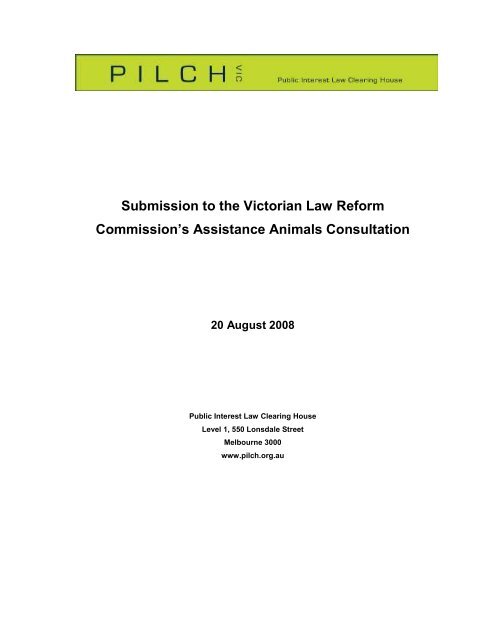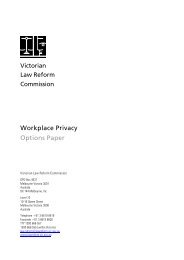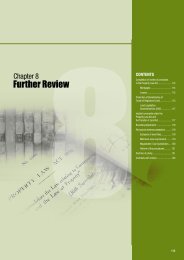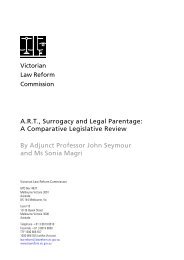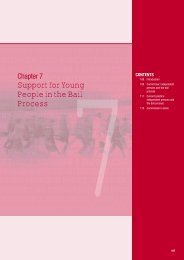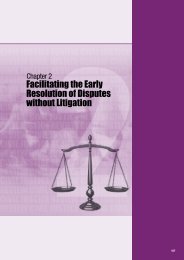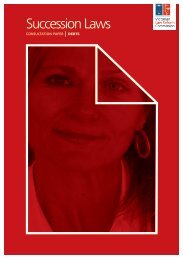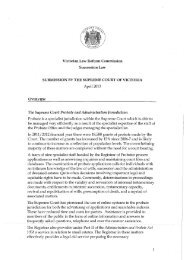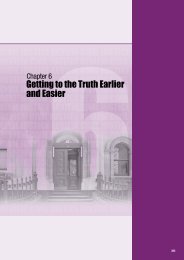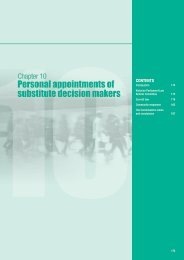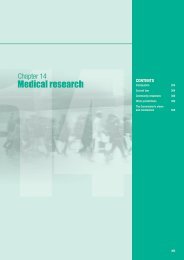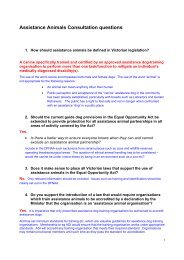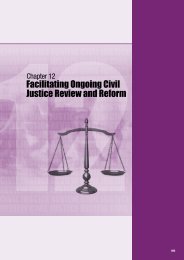Submission: Assistance Animals - pilch
Submission: Assistance Animals - pilch
Submission: Assistance Animals - pilch
You also want an ePaper? Increase the reach of your titles
YUMPU automatically turns print PDFs into web optimized ePapers that Google loves.
<strong>Submission</strong> to the Victorian Law ReformCommission’s <strong>Assistance</strong> <strong>Animals</strong>ConsultationMat Tinkler and Jane AdamsPublic Interest Law Clearing House (PILCH) IncLevel One, 550 Lonsdale StreetMelbourne VIC 3000T: (03) 9225 6680F: (03) 9225 6686El: mat.tinkler@<strong>pilch</strong>.org.au
PILCH <strong>Submission</strong> to the VLRC’s <strong>Assistance</strong> <strong>Animals</strong> Community ConsultationCONTENTSPart A - Introduction & recommendations 21 Introduction 22 Recommendations 2Part B – About this submission 43 About PILCH 44 Scope of this submission 5Part C – A human rights framework 65 Australia’s international human rights obligations 66 Other obligations at international law 77 The Victorian Charter 7Part D – The definition of ‘assistance animals’ 118 Consistent Commonwealth and Victorian laws 119 The notion of ‘trained’ 12Part E - Protection for assistance animal partnerships in the EqualOpportunity Act 1310 Protection for <strong>Assistance</strong> Animal Partnerships 1311 Guideline Making Power 1412 Training and accreditation 1613 Organisations vs individuals 1714 Appeal rights 1815 Identification 18Page 1
PILCH <strong>Submission</strong> to the VLRC’s <strong>Assistance</strong> <strong>Animals</strong> Community ConsultationPart A - Introduction & recommendations1 Introduction1.1 The Public Interest Law Clearing House (PILCH) welcomes the opportunity to contributeto the VLRC’s <strong>Assistance</strong> <strong>Animals</strong> Community Consultation (Consultation). Wecommend the VLRC on its initiative to undertake the Consultation.1.2 The following submission considers selected aspects of the Consultation paper, drawingfrom our experience as facilitators of pro bono legal assistance.2 Recommendations2.1 PILCH submits that the VLRC should recommend:(1) that the Consultation should measure the efficacy of Victoria’s legislativeframework in respect of assistance animals against Australia’s human rightsobligations to protect and promote the rights of persons with disabilities;:(2) that the definition of ‘assistance animal’ in the Equal Opportunity Act 1995 isreplaced with the definition used in section 9(1)(f) of the Disability DiscriminationAct 1992 (in order to promote consistency between federal and Victorian law);(3) that the definition of ‘assistance animal’ includes a definition of ‘trained’ whichmeans an animal trained and approved by an accredited trainer;(4) that the current guide dogs provisions in the EOA be extended to protect allassistance animal partnerships in all areas of activity covered by the EOA;(5) that all Victorian laws relating to assistance animals and assistance animalpartnerships should be included in the EOA and that section 7(4) of the Domestic(Nuisance and Feral) <strong>Animals</strong> Act be repealed;(6) that a positive right of access to assistance animal partnerships consistent with theDDA should be introduced into the EOA;(7) that the EOA should be amended to include an unjustifiable hardship provision thatis consistent with sections 15(4), 22(4), 23(4) 24(4) and 25(3)(c) of the DDA;(8) that the EOA should include a general guideline making power of Victorian EqualOpportunity and Human Rights Commission that is consistent with the power of theMinister under sections 31 and 32 of the DDA;Page 2
PILCH <strong>Submission</strong> to the VLRC’s <strong>Assistance</strong> <strong>Animals</strong> Community ConsultationPart B – About this submission3 About PILCH3.1 PILCH welcomes the opportunity to make a submission to the Consultation.3.2 PILCH is a leading Victorian, not-for-profit organisation which is committed to furtheringthe public interest, improving access to justice and protecting human rights by facilitatingthe provision of pro bono legal services and undertaking law reform, policy work andlegal education.3.3 PILCH coordinates the delivery of pro bono legal services through five schemes:• the Public Interest Law Scheme (PILS);• the Victorian Bar Legal <strong>Assistance</strong> Scheme (VBLAS);• the Law Institute of Victoria Legal <strong>Assistance</strong> Scheme (LIVLAS);• PILCH Connect (Connect);• the Homeless Persons’ Legal Clinic (HPLC); and• Seniors Rights Victoria (SRV).3.4 PILCH's objectives are to:1. improve access to justice and the legal system for those who are disadvantaged ormarginalised;2. identify matters of public interest requiring legal assistance;3. seek redress in matters of public interest for those who are disadvantage ormarginalised;4. refer individuals, community groups, and not for profit organisations to lawyers inprivate practice, and to others in ancillary or related fields, who are willing to providetheir services without charge;5. support community organisations to pursue the interests of the communities they seekto represent; and6. encourage, foster and support the work and expertise of the legal profession in probono and/or public interest law.3.5 In 2006-2007, PILCH assisted over 2000 individuals and organisations to access freelegal and related services. Without these much needed services, many Victorians wouldfind it impossible to navigate a complex legal system, secure representation, negotiate afine, challenge an unlawful eviction, contest a deportation or even be aware of their rightsand responsibilities.Page 4
PILCH <strong>Submission</strong> to the VLRC’s <strong>Assistance</strong> <strong>Animals</strong> Community Consultation4 Scope of this submission4.1 PILCH has drawn upon the terms of reference and limited this submission to aconsideration of key areas to which PILCH can offer particular insight and expertise.4.2 In particular, this submission focuses on <strong>Assistance</strong> <strong>Animals</strong> Consultation Paperquestions numbers 1-4, being:(1) How should assistance animals be defined in Victorian legislation?(2) Should the current guide dog provisions in the Equal Opportunity Act 1995 (Vic) beextended to provide protection for all assistance animal partnerships in all areas ofactivity covered by the Act?(3) Does it make sense to place all Victorian laws that support the use of assistanceanimals in the Equal Opportunity Act 1995 (Vic)?(4) Do you support the introduction of a law that would require organisations whichtrain assistance animals to be accredited by a declaration by the Minister that theorganisation is an “assistance animal organisation”?4.3 In doing so PILCH has considered relevant legislation, the common law in relation todiscrimination and regulation and control of domestic animals and Australia’sinternational human rights obligations.4.4 PILCH’s experience and expertise in relation to this submission is drawn from thefollowing:(1) the personal and professional experience of the authors;(2) observation and involvement in a number of discrimination cases through thefacilitation of pro bono legal assistance;(3) law reform activity, including a PILCH submission to the January 2008 review bythe Victorian Government of the Equal Opportunity Act 1995 (Vic);(4) case law and social research; and(5) community consultations.4.5 PILCH acknowledges the valuable assistance provided to this submission by Jane Wolfeand Charles Slattery of DLA Phillips Fox.Page 5
PILCH <strong>Submission</strong> to the VLRC’s <strong>Assistance</strong> <strong>Animals</strong> Community ConsultationPart C – A human rights framework5 Australia’s international human rights obligations5.1 PILCH considers that a necessary starting point for the Consultation is a consideration ofAustralia’s human rights obligations, particularly in relation to discrimination and therights of disabled persons.5.2 Australia is a party to various international human rights conventions, including theInternational Covenant on Civil and Political Rights (ICCPR) and the InternationalCovenant on Economic, Social and Cultural Rights (ICESCR). The ICCPR and ICESCRapply to everyone, including persons with disabilities, and protect against discriminationon any basis. The ICCPR and ICESCR do not, however, directly address the rights ofpersons of disabilities.5.3 The Convention on the Rights of Persons with Disabilities (CRPD) entered into force on 3May 2008. Australia become a signatory to the CRPD on 30 March 2007 and ratified it on17 July 2008. The CRPD states the human rights of persons with disabilities and clarifiesthe obligations on States to promote, protect and ensure those rights as well asmechanisms to support implementation and monitoring. By ratifying the CPRD it becameincumbent of all levels of Australian government, Federal, State and Territory, to meettheir obligations under the Convention.5.4 Although the CRPD does not include a specific definition of “disability” and “persons withdisabilities”, the following aspects of the CRPD provide guidance to clarify its application:• disability is recognised as “an evolving concept and that disability results from theinteraction between persons with impairments and attitudinal and environmentalbarriers that hinders their full and effective participation in society on an equal basiswith others” 1 ; and• persons with disabilities includes “those who have long-term physical, mental,intellectual or sensory impairments which in interaction with various barriers mayhinder their full and effective participation in society on an equal basis with others” 25.5 The CRPD does not address expressly assistance animals. However, the CPRDemphasises that persons with disabilities are entitled to full and effective participationand inclusion in society, as illustrated in the following CPRD articles:(a)Accessibility: “To enable persons with disabilities to live independently andparticipate fully in all aspects of life, State Parties shall take appropriate measuresto ensure to persons with disabilities access, on an equal basis with others, to the1 CRPD, Preamble (e).2 Ibid, Article 1.Page 6
PILCH <strong>Submission</strong> to the VLRC’s <strong>Assistance</strong> <strong>Animals</strong> Community Consultationphysical environment, to transportation, to information and communications,including information and communications technologies and systems, and to otherfacilities and services open or provided to the public, both in urban and ruralareas.” This includes “ensuring that private entities that offer facilities and serviceswhich are open or provided to the public take into account all aspects ofaccessibility for persons with disabilities”; 3(2) Living independently and being included in the community: “State Parties…recognize the equal right of all persons with disabilities to live in the community,with choices equal to others, and shall take effective and appropriate measures tofacilitate full enjoyment by persons with disabilities of this right and their fullinclusion and participation in the community”. This includes ensuring that“[p]ersons with disabilities have access to a range of in-home, residential and othercommunity support services, including personal assistance necessary to supportliving and inclusion in the community, and to prevent isolation or segregation fromthe community”; 4 and(3) Personal mobility: “State Parties shall take effective measures to ensure personalmobility with the greatest possible independence for persons with disabilities.” Thisincludes “[f]acilitating access by persons with disabilities to quality mobility aids,devices, assistive technologies and forms of live assistance and intermediaries,including by making them available at affordable cost.” 56 Other obligations at international law6.1 In addition to being bound by the terms of the conventions such as the CRPD and ICCPR,Australia is also bound by the content and terms of customary international human rights lawwhich imposes responsibilities and obligations in relation to the realisation of the rightsprotected by the ICCPR (among other covenants); namely obligations to respect, protect andfulfil human rights 6 .6.2 The obligation to respect human rights requires that States parties refrain from interfering,directly or indirectly, with enjoyment of human rights. The obligation to protect human rightsrequires that States parties prevent third parties, including organisations and individuals, frominterfering in any way with the enjoyment of human rights. The obligation to fulfil human rightsrequires that States parties take positive steps to promote and support the realisation ofhuman rights and, where necessary, to provide for the realisation of human rights formarginalised or disadvantaged groups.7 The Victorian Charter7.1 The Victorian Charter (which entered into full force on 1 January 2008) enshrines a bodyof civil and political rights derived from the ICCPR. The substantive rights recognised in3 CRPD, Article 94 Ibid, Article 195 Ibid, Article 206 UN Committee on Economic, Social and Cultural Rights, General Comment 15: The Right to Water, [17]–[29], UN DocE/C.12/2002/11 (2002). See also UN Committee on Economic, Social and Cultural Rights, General Comment 12: The Rightto Adequate Food, 66, [15], UN Doc HRI/GEN/1/Rev.5 (2001) and UN Committee on Economic, Social and Cultural Rights,General Comment 13: The Right to Education, 74, [47], UN Doc HRI/GEN/1/Rev.5 (2001).Page 7
PILCH <strong>Submission</strong> to the VLRC’s <strong>Assistance</strong> <strong>Animals</strong> Community Consultationthe Victorian Charter include the fundamental rights to non-discrimination and equalitybefore the law. 7 The Victorian Charter also protects the right to freedom of movementwithin Victoria. 87.2 The Victorian Charter establishes a 'dialogue model' of human rights protection whichseeks to ensure that human rights are taken into account when developing, interpretingand applying Victorian law and policy without displacing current constitutionalarrangements. The dialogue between the various arms of government — namely, thelegislature, the executive (which includes 'public authorities' 9 ) and the courts — isfacilitated through a number of mechanisms including:(1) public authorities must act compatibly with human rights and also give properconsideration to human rights in any decision-making process; and(2) so far as possible, those interpreting and applying legislation must do soconsistently with human rights and with regard to relevant international, regionaland comparative domestic jurisprudence. 107.3 The following overarching principles should be considered in the interpretation andapplication of the Victorian Charter in conducting the Consultation:(1) Division 1 of Part 3 of the Victorian Charter requires that all new legislationintroduced in Victoria be considered for its compatibility with the human rights setout in the Victorian Charter. Accordingly, in considering whether to reform the lawregarding assistance animals, VLRC should take into account the human rights setout in the Victorian Charter and their implication for the Consultation.(2) Section 32(1) of the Victorian Charter states:So far as it is possible to do so consistently with their purpose, allstatutory provisions must be interpreted in a way that is compatiblewith human rights.The purpose and effect of this provision is to require that any person or entity thatinterprets and applies legislation does so in a way that gives effect to human rights.7 Victorian Charter, section 12.8 Ibid, section 8.9 Ibid, section 4 defines public authority.10 Section 32(1) requires, as a matter of law, that a human rights consistent interpretation be adopted whenever it is possibleto do so, regardless of whether there is any ambiguity and regardless of how the provision in question may have beenpreviously interpreted and applied. Victorian Charter s 49(1). See, eg, R v Offen [2001] 2 All ER 154 which held that, inlight of the interpretative requirement under the Human Rights Act 1998 (UK), a decision made a year earlier in relation tothe interpretation and application of a provision of the Criminal (Sentences) Act 1977 was no longer good law. See also ReS (Care Order: Implementation of Care Plan) [2002] AC 291, 313.Page 8
PILCH <strong>Submission</strong> to the VLRC’s <strong>Assistance</strong> <strong>Animals</strong> Community Consultation(3) The human rights contained in the Victorian Charter are largely modelled on thecivil and political rights enshrined in the ICCPR. 11There is a vast body ofinternational and comparative jurisprudence that can, and therefore, should beconsidered in the elucidation of the content and application of the VictorianCharter.(4) The Victorian Charter is founded on the principle that human rights are essential ina democratic and inclusive society that respects the rule of law, human dignity,equality and freedom. Having regard to this, the rights should be interpretedbroadly 12 which ensures that a flexible and individualised approach is employed.(5) The rights should be interpreted and applied in a manner which renders them‘practical and effective, not theoretical and illusory’. 13 Consistently with the natureof human rights obligations articulated by the HRC (namely, that states haveobligations to respect, protect and fulfil human rights) 14 and the approach adoptedby UK courts under the Human Rights Act 1998 (UK) and the European Court ofHuman Rights under the European Convention on Human Rights, 15 rights mayimpose both negative and positive obligations on public authorities.(6) The Victorian Charter is a ‘living document’ which should be interpreted andapplied in the context of contemporary and evolving values and standards. 16European Court of Human Rights has stated that:TheThe Convention is a living instrument which must be interpreted in light ofpresent day conditions…the increasingly high standard being required in thearea of the protection of human rights and fundamental liberties11 Opened for signature 16 December 1966, 999 UNTS 171 (entered into force 23 March 1976). Many of these civil andpolitical rights are also enshrined in regional human rights instruments (such as the European Convention on HumanRights) and domestic human rights instruments (such as the United Kingdom Human Rights Act 1998).12 See, eg, UN Human Rights Committee, General Comment No 6: The Right to Life (1982) [5], available fromhttp://www.ohchr.org/english/bodies/hrc/comments.htm.13 Goodwin v United Kingdom (2002) 35 EHRR 447, [73]-[74]. See also Airey v Ireland (1979) 2 EHRR 305, 314.14 See,eg, UN Human Rights Committee, General Comment 3: Implementation at the National Level, UN DocHRI\GEN\1\Rev.1 (1981) available at http://www.ohchr.org/english/bodies/hrc/comments.htm in which the HRC stated:The Committee considers it necessary to draw the attention of States parties to the fact that the obligation underthe Covenant is not confined to the respect of human rights, but that States parties have also undertaken toensure the enjoyment of these rights to all individuals under their jurisdiction. This aspect calls for specificactivities by the States parties to enable individuals to enjoy their rights.15 See, eg, Marckx v Belgium (1979) 2 EHRR 330; Gaskin v United Kingdom (1989) 12 EHRR 36; Airey v Ireland (1979) 2EHRR 305; Plattform Artze fur das Leben v Austria (1988) 13 EHRR 204.16 Tyrer v United Kingdom (1978) 2 EHRR 1, 10.Page 9
PILCH <strong>Submission</strong> to the VLRC’s <strong>Assistance</strong> <strong>Animals</strong> Community Consultationcorrespondingly and inevitably requires firmness in assessing breaches ofthe fundamental values of democratic societies. 17(7) Recognising that human rights are interdependent and indivisible, the rights shouldbe read so as to complement and reinforce each other.7.4 PILCH emphasises the importance of a human rights approach to conducting theConsultation and drafting responses to the questions posed.Recommendation 1The Consultation should measure the efficacy of Victoria’s legislative framework in respect ofassistance animals against Australia’s human rights obligations (including the Victorian Charter) toprotect and promote the rights of persons with disabilities.17 Selmouni v France (2000) 29 EHRR 403, [101].Page 10
PILCH <strong>Submission</strong> to the VLRC’s <strong>Assistance</strong> <strong>Animals</strong> Community ConsultationPart D – The definition of ‘assistance animals’8 Consistent Commonwealth and Victorian laws8.1 PILCH supports the VLRC’s proposal that the definition of ‘assistance animal’ in theEqual Opportunity Act 1995 (Vic) (EOA) is amended so that it is consistent with the rightscontained in the Disability Discrimination Act 1992 (Cth) (DDA).8.2 Currently the EOA only recognises ‘guide dogs’ that assist people with visual, hearingand mobility impairments 18 , whereas the DDA recognises all types of disabilities andcontains a broad definition of ‘assistance animal’ which includes:(1) guide dogs;(2) dogs trained to assist the aggrieved person in activities where hearing is required,or because of any matter related to that fact; and(3) any other animal trained to assist the aggrieved person to alleviate the effect of thedisability, or because of any matter related to that fact. 198.3 PILCH’s preferred approach is that the DDA definition of ‘assistance animal’ should applyto the EOA for the following reasons:(1) the EOA needs to recognise and protect persons with all types of disabilities(including persons with psychiatric disabilities) in order to promote consistency withthe broad recognition of disabilities under the DDA and the Convention on theRights of Persons with Disabilities (CRPD)20; and(2) as a federal law, the DDA overrides any Victorian law that is inconsistent with itsown assistance animal provisions. The EOA therefore needs to be consistent withthe DDA in order to help ensure that all people with disabilities enjoy equalprotection.Recommendation 2PILCH recommends that the definition of ‘assistance animal’ in the EOA is replaced with thedefinition used in section 9(1)(f) of the DDA, in order to promote consistency between federaland Victorian law18 EOA, section 4(1)19 DDA, section 920 CPRD, Preamble (e) and Article 1.Page 11
PILCH <strong>Submission</strong> to the VLRC’s <strong>Assistance</strong> <strong>Animals</strong> Community Consultation9 The notion of ‘trained’9.1 PILCH however does recognise the VRLC’s concerns 21 that there is a very real risk that abroad definition (such as the DDA definition) of ‘assistance animal’ may allow for species ofanimals that the community does not accept as appropriate, which could have a negativeimpact on public confidence in current assistance animals such as guide dogs.9.2 In particular, PILCH recognises that the DDA definition of ‘assistance animal’ is problematicin that the term ‘trained’ is not defined, as Justice Collier observes in Forest v QueenslandHealth [2007] FCA 936 (22 June 2007):It is perhaps unfortunate that the DDA does not, like the Guide Dogs Act 1972(Qld) or the Dog Control Act 1996 (NZ), define assistance animals by reference toaccredited training organisations. This would provide certainty for animal owners,service providers and members of the public, and strike a balance between theneeds of the disabled as recognised in the DDA and the confidence of serviceproviders and the public as to standards of assistance animals in public places.9.3 Accordingly, PILCH recommends that the definition of ‘assistance animal’ in the EOAincludes a definition of ‘trained’ which means an animal trained and approved by anaccredited trainer. 'Accredited trainer' should be defined to mean a trainer approved bythe <strong>Assistance</strong> <strong>Animals</strong> Board as recommended by Part F of this submission (or otherapproved training organisation as the VLRC recommends).Recommendation 3PILCH recommends that the definition of ‘assistance animal’ in the EOA includes a definitionof ‘trained’ which means an animal trained and approved by an accredited trainer.21 <strong>Assistance</strong> <strong>Animals</strong> Consultation Paper, 5.20Page 12
PILCH <strong>Submission</strong> to the VLRC’s <strong>Assistance</strong> <strong>Animals</strong> Community ConsultationPart E - Protection for assistance animal partnerships inthe Equal Opportunity Act10 Protection for <strong>Assistance</strong> Animal Partnerships10.1 PILCH supports the proposal that the current guide dogs provisions in the EqualOpportunity Act 1995 (Vic) (EOA) 22 should be extended to protect all assistance animalpartnerships in all areas of activity covered by the EOA. In particular, PILCHrecommends:(1) the definition of 'guide dog' to be amended to 'assistance animal' and to includeanimals trained to assist persons with visual, hearing or mobility impairment orother recognised/diagnosed medical condition;(2) 'recognised/diagnosed medical condition' to be defined and to include mentalimpairment, conditions such as epilepsy, autism or any other recognisedimpairment requiring the use of an assistance animal;(3) 'assistance Partnership' to be defined, to refer to the partnership/relationshipbetween a person with a visual, hearing or mobility impairment or otherrecognised/diagnosed medical condition and their assistance animal;(4) provisions of the EOA to be amended where applicable to replace references to'guide dog' with 'assistance animal' and to replace references to persons with'visual, hearing or mobility impairment' with references to persons with 'visual,hearing or mobility impairment or other recognised/diagnosed medical condition';10.1 While PILCH believes that dedicated legislation should deal with the regulation ofassistance animals and assistance animal trainers (see Part F, below), PILCH supportsthe proposal that all Victorian laws relating to the protection of assistance animalpartnerships should be included in the EOA and that section 7(4) of the Domestic(Nuisance and Feral) <strong>Animals</strong> Act be repealed. To reduce the possibility of inconsistentinterpretation, and to provide ease of access/reference to applicable legislation, it ispreferable to consolidate laws relating to the protection of assistance animalpartnerships.10.2 PILCH supports the introduction into the EOA of a positive right of access to assistanceanimal partnerships consistent with the Disability Discrimination Act 1992 (Cth) (DDA) forthe following reasons:22 Equal Opportunity Act 1995 (Vic), s52.Page 13
PILCH <strong>Submission</strong> to the VLRC’s <strong>Assistance</strong> <strong>Animals</strong> Community Consultation(1) the 'reasonable accommodation' approach does not provide sufficient certainty toassistance animal partnerships and places disproportionate discretion as to what isreasonable in the hands of service providers;(2) a positive right to access sends a strong message to accommodation providersthat assistance animal partnerships are to be treated in a non-discriminatoryfashion; and(3) a positive right test enables people with a disability to assert with confidence theirright to be accompanied by an assistance animal. This is a fundamental objectiveof the EOA Reform which will not be provided if the reasonable accommodationapproach is adopted.10.3 Further, PILCH considers that the EOA should be amended to include an unjustifiablehardship provision that is consistent with sections 15(4), 22(4), 23(4) 24(4) and 25(3)(c) ofthe DDA.11 Guideline Making Power11.1 PILCH supports the inclusion into the EOA of a general guideline making power ofVEOHRC that is consistent with the power of the Minister under sections 31 and 32 of theDDA. Such a power will clarify the law for both service providers and animal assistancepartnerships.11.2 PILCH considers that VEOHRC should have the power to make guidelines it considersnecessary regarding assistance animals, using section 31 of the DDA as a benchmark.This would allow VEOHRC guidelines regarding assistance animals to be considered byVictorian courts and tribunals when considering discrimination claims.Recommendation 4PILCH supports the proposal that the current guide dogs provisions in the EOA be extended toprotect all assistance animal partnerships in all areas of activity covered by the EOA.Recommendation 5PILCH supports the proposal that all Victorian laws relating to the protection of assistance animalpartnerships should be included in the EOA and that section 7(4) of the Domestic (Nuisance andFeral) <strong>Animals</strong> Act be repealed.Page 14
PILCH <strong>Submission</strong> to the VLRC’s <strong>Assistance</strong> <strong>Animals</strong> Community ConsultationRecommendation 6PILCH supports the introduction into the EOA of a positive right of access to assistance animalpartnerships consistent with the DDA.Recommendation 7PILCH considers that the EOA should be amended to include an unjustifiable hardship provisionthat is consistent with sections 15(4), 22(4), 23(4) 24(4) and 25(3)(c) of the DDA.Recommendation 8PILCH supports the inclusion into the EOA of a general guideline making power of VictorianEqual Opportunity and Human Rights Commission that is consistent with the power of theMinister under sections 31 and 32 of the DDA.Page 15
PILCH <strong>Submission</strong> to the VLRC’s <strong>Assistance</strong> <strong>Animals</strong> Community ConsultationPart F – Training, accreditation and identification12 Training and accreditation12.1 PILCH supports the introduction of a law that would require organisations which trainassistance animals to be accredited. However, PILCH does not consider thataccreditation via Ministerial declaration is the most appropriate way to accredit approvedorganisations.12.2 PILCH considers that it is desirable that new, dedicated legislation be enacted to dealwith the regulation of assistance animals. A dedicated Act would generate significantpublic and parliamentary debate which would enhance community awareness of theimportance of assistance animals and highlight the shortcomings of the present regime,PILCH considers that the centralised accreditation scheme for assistance animalsestablished by the Dog and Cat Management Act 1995 (SA) provides a useful startingpoint. Under that Act, the Dog and Cat Management Board has, subject to Ministerialcontrol 23 , responsibility for the accreditation of a dog as a disability dog, guide dog, or ahearing dog 24 .12.3 The Dog and Cat Management Board is comprised on members nominated by theMinister and the South Australian Local Government Association and required attributesinclude veterinary experience in the care and treatment of dogs or cats; a demonstratedinterest in the welfare of dogs or cats; and a demonstrated interest in the keeping andmanagement of dogs or cats 25 .12.4 PILCH considers that there are several advantages in adopting a centralisedaccreditation scheme for approved assistance animal organisations, including that:(1) the scheme can be administered by a board with expertise in the training, welfareand accreditation of assistance animals;(2) deliberations of the board can be transparent (and therefore decisions are moreaccountable) 26 ;(3) an expert board with responsibility for accrediting assistance animal organisationswill be better placed to observe industry developments and to respond anysystemic issues that may arise.23 Dog and Cat Management Act 1995, ss 10 and 1124Ibid, s21A25 Ibid, s12(2a)26 See, for example, s11(2) of the Dog and Cat Management Act 1995 which provides that ‘No Ministerial direction can begiven to suppress information or recommendations from a report by the Board under this Act’Page 16
PILCH <strong>Submission</strong> to the VLRC’s <strong>Assistance</strong> <strong>Animals</strong> Community Consultation12.5 PILCH agrees with the VLRC’s suggestion to accredit trainers of assistance animalsrather than the animals themselves 27 . PILCH considers that, upon completion of trainingby an accredited trainer, animals should achieve the status of an assistance animal.12.6 Accordingly, PILCH recommends the establishment of an ‘<strong>Assistance</strong> <strong>Animals</strong> Board’with responsibility for the accreditation of organisations and individuals approved toconduct assistance animal training.12.7 The Board should be comprised of members nominated by the Minister and Appointedby the Governor in Council and include minimum appointees with experience andexpertise in the following:(1) the training of assistance animals;(2) veterinary care and treatment of animals;(3) assistance animal regulation in comparative jurisdictions;(4) legal practice 28 .Recommendation 9PILCH recommends the establishment of an <strong>Assistance</strong> <strong>Animals</strong> Board comprised of relevantexperts and which is responsible for the accreditation of approved assistance animal trainers.13 Organisations vs individuals13.1 PILCH agrees with the VLRC’s suggestion that, in order to be eligible for approval as anassistance animal trainer, trainers should be required to meet minimum standards set outin guidelines consistent with the approach for ‘applicable organisations’ under s5 of theDFNAA 29 .13.2 Provided trainers meet such standards, PILCH sees no basis to discriminate betweenorganisations and individuals in terms of who may be approved as an accreditedassistance animal trainer. The VLRC’s concern regarding the potential administrativeburden on the Bureau of Animal Welfare can be addressed by the establishment of the<strong>Assistance</strong> <strong>Animals</strong> Board.13.3 PILCH considers that an important objective of the Consultation is to facilitate morepeople with properly trained assistance animals. Arbitrarily restricting the ability ofproperly qualified individuals to accredit assistance animals seems counterproductive tosuch an aim.27 <strong>Assistance</strong> <strong>Animals</strong> Consultation Paper, pp 5.7428 For analogous board composition, see for example the Veterinary Practice Act 1997, s6329 <strong>Assistance</strong> <strong>Animals</strong> Consultation Paper, pp 5.72Page 17
PILCH <strong>Submission</strong> to the VLRC’s <strong>Assistance</strong> <strong>Animals</strong> Community Consultation13.4 Moreover, if the effect of such an arbitrary restriction is to reduce the effective realisationof the human rights of people in need of assistance animals to adequately exercise thoserights, such a restriction may be in breach of the States’ human rights obligations. Forexample, the principles of accessibility, living independently and being included in thecommunity under CPRD 30 .Recommendation 10PILCH recommends that organisations and individuals should be eligible for accreditation asapproved assistance animal trainers.14 Appeal rights14.1 PILCH agrees with the VLRC’s proposal to allow appeal rights for applicants that arerefused accreditation as an ‘assistance animal organisation’.14.2 PILCH considers that the Victorian Civil and Administrative Tribunal (VCAT) is anappropriate forum for a hearing de novo in such circumstances.14.3 VCAT’s Occupational and Business Regulation List has a combination of both originaljurisdiction and jurisdiction to hear matters on review, including in analogouscircumstances such as under the Veterinary Practice Act 1997 31 .14.4 However, in the event that an <strong>Assistance</strong> <strong>Animals</strong> Board is established the VLRC maywish to consider alternatives such as allowing an initial accreditation to be made by aBoard subcommittee followed by an appeal at first instance to the full Board.Recommendation 11PILCH recommends appeal rights for applicants that are refused accreditation as an ‘assistanceanimal organisation’ to VACT.15 Identification15.1 While PILCH has not commented upon the elements of an appropriate registrationsystem, we support the VLRC’s proposal to require registered assistance animalpartnerships to be issued with an appropriate identification card.30 CRPD, Articles 9, 19 and 20 and discussed at paragraph 5.5, above31 Veterinary Practice Act 1997, Part 4Page 18
PILCH <strong>Submission</strong> to the VLRC’s <strong>Assistance</strong> <strong>Animals</strong> Community Consultation15.2 However, PILCH considers that an identification card in isolation will be insufficient tomeaningfully reduce incidence of discrimination against assistance animal users. Inparticular, an identification card that is produced upon request will do little to increasepublic awareness and acceptance of the use of assistance animals.15.3 Guide dogs are immediately recognisable to the public via a distinctive harness, often inconjunction with a coloured jacket. PILCH considers that such recognition might operateto diffuse situations where people would otherwise be uncomfortable in allowing accessto businesses or transport etc for a person accompanied by a dog.15.4 Accordingly, PILCH recommends that assistance animals be required or encouraged (viafinancial supplements if necessary) to wear a distinctive visual identifier such as acoloured jacked or harness. This should be accompanied by a community awarenesscampaign to raise the public awareness of the law in relation to assistance animals andreduce instances of discrimination.Recommendation 12PILCH recommends that assistance animals be required to wear a distinctive visual identifier inorder to raise public awareness and acceptance of assistance animal partnerships.Page 19


